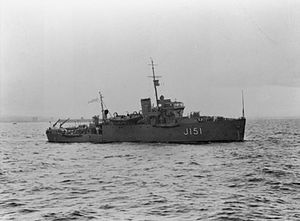HMS Clacton (J151)

| |
| History | |
|---|---|
| Name | HMS Clacton |
| Builder | Ailsa Shipbuilding Co. Ltd., Troon, Scotland |
| Laid down | 12 November 1940 |
| Launched | 18 December 1941 |
| Commissioned | 4 June 1942 |
| Fate | Sunk by a mine on 31 December 1943 |
| General characteristics | |
| Class and type | Bangor-class minesweeper |
| Displacement |
|
| Length | 174 ft (53 m) o/a |
| Beam | 28 ft 6 in (8.69 m) |
| Draught | 10 ft 3 in (3.12 m) |
| Installed power |
|
| Propulsion |
|
| Speed | 16 knots (30 km/h; 18 mph) |
| Range | 2,800 nmi (5,200 km; 3,200 mi) at 10 knots (19 km/h; 12 mph) |
| Complement | 60 |
| Armament |
|
HMS Clacton was a Bangor-class minesweeper built for the Royal Navy during the Second World War.
Design and description
The Bangor class was designed as a small minesweeper that could be easily built in large numbers by civilian shipyards; as steam turbines were difficult to manufacture, the ships were designed to accept a wide variety of engines. Clacton displaced 656 long tons (667 t) at standard load and 820 long tons (830 t) at deep load. The ship had an overall length of 174 feet (53.0 m), a beam of 28 feet 6 inches (8.7 m) and a draught of 10 feet 3 inches (3.1 m).[1] The ship's complement consisted of 60 officers and ratings.[2]
She was powered by two Parsons geared steam turbines, each driving one shaft, using steam provided by two Admiralty three-drum boilers. The engines produced a total of 2,000 shaft horsepower (1,500 kW) and gave a maximum speed of 16 knots (30 km/h; 18 mph). Clacton carried a maximum of 160 long tons (163 t) of fuel oil that gave her a range of 2,800 nautical miles (5,200 km; 3,200 mi) at 10 knots (19 km/h; 12 mph).[3]
The turbine-powered Bangors were armed with a 3-inch (76 mm) anti-aircraft gun and a single QF 2-pounder (4 cm) AA gun. In some ships the 2-pounder was replaced a single or twin 20 mm Oerlikon AA gun, while most ships were fitted with four additional single Oerlikon mounts over the course of the war.[3] For escort work, her minesweeping gear could be exchanged for around 40 depth charges.[2]
Construction and career
HMS Clacton was built by Ailsa Shipbuilding Co. Ltd., at Troon, Scotland and launched on 18 December 1941. Thus far she has been only the second ship of the Royal Navy named after the Essex town of Clacton-on-Sea. HMS Clacton was in the Mediterranean off the east coast of Corsica, on passage from La Maddalena to Bastia on 31 December 1943. She struck a mine at 0832 hours and sank immediately. Three officers and 29 ratings were killed, with the survivors being rescued by HMS Polruan.
References
Bibliography
- Chesneau, Roger, ed. (1980). Conway's All the World's Fighting Ships 1922–1946. Greenwich, UK: Conway Maritime Press. ISBN 0-85177-146-7.
- Colledge, J. J.; Warlow, Ben (2006) [1969]. Ships of the Royal Navy: The Complete Record of all Fighting Ships of the Royal Navy (Rev. ed.). London: Chatham Publishing. ISBN 978-1-86176-281-8.
- Lenton, H. T. (1998). British & Empire Warships of the Second World War. Annapolis, Maryland: Naval Institute Press. ISBN 1-55750-048-7.
